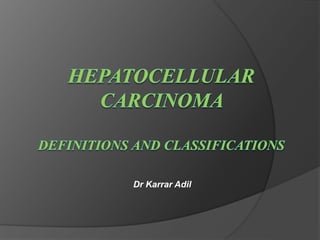
Hepatocellular carcinoma.pptx
- 2. Introduction : Hepatocellular carcinoma (HCC) is a primary malignant tumor of the liver with hepatocellular differentiation. Its incidence is increasing; becoming 5th most common malignancy worldwide. HCC is the commonest primary liver malignancy (90%). however, secondaries are the most common malignancy in the liver (20 times more common than primary). It is common in cirrhotics and hepatitis B and hepatitis C virus infection. Male to female ratio is 4:1. Right lobe is commonly involved.
- 3. Eggel's Classification : Nodular form : (65%) occurs as solitary or multiple nodules vary in size sharply demarcated. Massive form : (23%) involving the whole of the right or left lobe. not well demarcated accompanied by small intrahepatic metastatic nodules. Diffuse form : (12%) Numerous small foci Difficult to distinguish from the pseudolobules of liver cirrhosis.
- 4. Macroscopic classification : Vaguely nodular type Expanding nodular type Multinodular confluent type Nodular with perinodular extension type Infiltrative type Specific types : • Pedunculated • Cirrhotomimetic
- 5. Vaguely nodular type multinodular confluent type nodular with perinodular extension type infiltrative type cirrhotomimetic type expanding nodular type
- 6. Vaguely nodular (VN) type : defined as a nodule with indistinct margins. Expanding nodular (EN) type : defined by as a round expansile nodule with a distinct margin. Multinodular confluent (MC) type : defined as a cluster of small and confluent nodules.
- 7. Nodular with perinodular extension (NP) type : defined as an expanding nodule similar to EN type that had extranodular growth in less than 50% of the tumor circumference. Infiltrative (INF) type : showed extranodular growth in more than 50% of the tumor circumference.
- 8. Classification according to staging systems
- 9. Staging systems in hepatocellular carcinoma : TNM stage The Okuda classification The Cancer of the Liver Italian Program (CLIP) score The Barcelona‐Clínic Liver Cancer (BCLC) staging system The French classification Chinese University Prognostic Index (CUPI) Japan Integrated Staging (JIS)
- 10. Okuda staging system : The Okuda system is a prognostic score introduced in 1985. Okuda and colleagues devised a staging system based on four factors representing advanced disease. This includes: 1. tumor occupying greater or less than 50% of the liver. 2. the presence or absence of ascites. 3. serum albumin level. 4. serum bilirubin level.
- 11. The system’s biggest shortcoming is its relatively crude classification of early stage patients and subsequent staging systems have tried to better characterize Okuda Stage I patients. the Okuda system remains the standard against which newer scoring systems are compared.
- 12. (I: not advanced; II: moderately advanced; III: very advanced)
- 13. Cancer of the Liver Italian Program (CLIP) score : was proposed by an Italian group in 1998. takes into account both liver function and tumor characteristics. It has been found superior to Okuda staging and TNM staging with greater predictive power.
- 14. It is based on 4 factors : 1. the Child-Pugh status of the patient. 2. tumor characteristics including tumor morphology and extension. 3. portal vein thrombosis. 4. levels of alfa-fetoprotein (AFP).
- 15. Summary of child-pugh score : • Stage A : 5-6 points • Stage B : 7-9 points • Stage C : 10-15 points
- 16. • Patients are classified into 7 groups according to the sum of these scores (0-6). • clip 0-3 : Early disease with potential long-term survival. • clip 4-6 : Advanced stage.
- 17. The Barcelona-Clinic Liver Cancer (BCLC) staging system : The BCLC classification was first published in 1999. is considered the standard HCC system by the American Association of the Study of Liver Disease (AASLD) and European Association for the Study of the Liver. takes into account size and extent of the primary tumor, liver function, physiological factors and incorporates the Okuda stage and Child-Pugh score.
- 18. this classification is best suited for treatment guidance, and particularly to select early stage patients who could benefit from curative therapies. In that sense, it has been validated as the best staging system in patients with early HCC.
- 19. Performance status (PS) : is a scale to grade how well the patient is. The BCLC staging system uses the Eastern Cooperative Oncology Group (ECOG) scale : • PS 0 : fully active, able to carry on all pre-disease performance without restriction. • PS 1 : restricted in physically strenuous activity but ambulatory and able to carry out work of a light or sedentary nature. • PS 2 : ambulatory and capable of all self-care but unable to carry out any work activities, up about more than 50% of waking hours. • PS 3 : capable of only limited self-care, confined to bed or chair more than 50% of waking hours. • PS 4 : completely disabled, cannot carry on any self-care, totally confined to bed or chair.
- 22. Thank you …